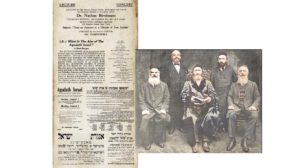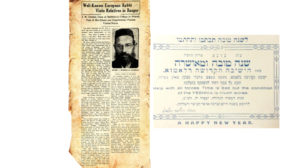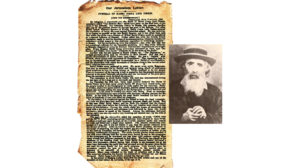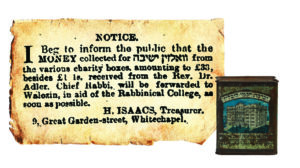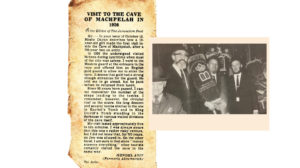Life After the Gulag

Walking on Rechov Chanah in Jerusalem’s Shikkun Chabad, you’ll notice a street sign posted on a set of steps. “Maalos HaRav Nanes” the sign declares, commemorating a man who survived twenty years in the Soviet Gulag, later moving to Eretz Yisrael and teaching Torah to hundreds who visited his house on Rechov Chanah.
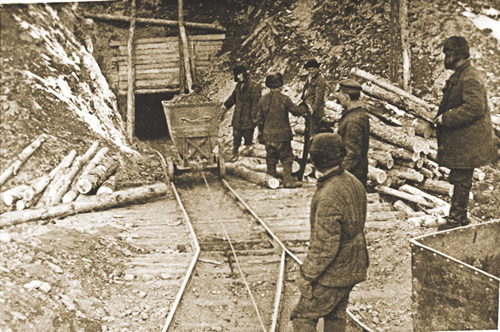
I t had always been Berel Neumark’s intention to celebrate his uncle Reb Eliezer Nanus’s 100ths birthday by throwing him a large party. Unfortunately that birthday never arrived. Instead Reb Leizer as he was affectionately called passed away just three months short of the landmark date. Rav Leizer’s passing thirteen years ago marked the end of an era – in which people who survived Stalin’s Gulag were still alive and approachable eager to share the miracles of their triumph.
You may not recognize the name Eliezer (Leizer) Nanes but you may very well know his story. After spending twenty years in the Soviet Gulag and never once desecrating Shabbos or Yom Tov Reb Leizer Nanes wrote a book documenting his experiences there. His story has come to epitomize the spirit of a unique group of Russian Jews who kept Yiddishkeit with extraordinary mesirus nefesh. These were Jews who defied the anti-Semitic onslaught during government-inspired pogroms under Russian Czar Nicholas II which eventually morphed into a direct assault on Yiddishkeit during the Bolshevik Revolution and throughout the Communist era. They did so by building an underground network of chedarim yeshivos shuls and mikvaos — all the elements that characterize Orthodox Jewish identity. They often paid a heavy price for their efforts but their personal sacrifices enabled vestiges of Yiddishkeit to survive in the Soviet regime.
The name Eliezer Nanes is unfamiliar because he wrote his book Subbota (Shabbos in Russian) under the pseudonym Avraham Netzach. Reb Leizer earned the nickname “Subbota” when he was forced to stand on a watchtower with his upper body exposed to the frigid Siberian winter air with a sign stating “Subbota” hanging from his neck for refusing to work on Shabbos or Yom Tov. The book first appeared in print in Yiddish in 1972 a year before Aleksandr I. Solzhenitsyn’s The Gulag Archipelago was published and it was translated into English in 1979. The book has long been out of print – anyone willing to sell their copy demands a hefty price for it — and Reb Leizer’s family members are in the process of reprinting an expanded version of the book.
The “Crime”
Reb Leizer was originally imprisoned for helping to sustain a network of underground chedarim. He accepted this task when his father-in-law, Rav Avraham Eliyahu Neumark, rav of Rostov on the Don, died of a massive heart attack attributed to intense fear and pressure while running this secret network. At that point, Stalin was trying to bolster his control of the Communist Party. He initiated the “Great Purge,” eliminating officials and individuals perceived as threats. These so-called undesirables were either shot or sent to Siberian labor camps.
In 1935, Reb Leizer was sentenced to one of these camps, where he was labeled a Counter-Revolutionary, or CR. Being a CR was considered the most serious crime in Communist Russia.
Most people would never have survived the initial ten-year sentence — and would certainly not have endured the ten years added after he refused to work on Shabbos — but survive Reb Leizer did, never compromising halachic standards, even slightly. He writes: “It was only Shabbos and religious observance that sustained my existence.”
Reb Leizer also utilized all resources at his disposal to provide food to starving Jews, saving many lives that way, and he taught Torah to Jewish prisoners from both Orthodox and non-Orthodox backgrounds.
His fearlessness and his strict adherence to his religious principles earned him respect, even admiration, from his Gulag cellmates, many of whom were thieves or murderers. “He turned murderers into people who cared,” explains Berel Neumark, Reb Leizer’s nephew.
But Subbota tells only the story of Reb Leizer’s years in the Gulag, not his remarkable accomplishments before and after the two-decade sentence. Where did Reb Leizer draw the strength to hold fast to Yiddishkeit under the brutal conditions of the Gulag? And what does a refusenik do after he is freed?
Four Births
Rabbi Binyamin Silberstrom cared for Reb Leizer in the last fifteen years of the latter’s life. He authored a biography, Ha’Ish Shelo Nichna (The Man Who Would Not Yield), in which he writes that Reb Leizer came to see his life as a series of four distinct births, each of which contributed toward furthering his spiritual growth: the 5th of Sivan 5657/1897, his physical birthday; the 12th of Iyar 5716/1956, the day he was released from Siberia; the 15th of Av 5726/1966, when he left Russia for Israel; and the 21st of Tishrei 5728/1967, when he visited the Lubavitcher Rebbe in Crown Heights, New York, for the first time, and received a mandate to spend his time teaching Chassidus to both men and women.
Born in Odessa to Reb Mordecai Aryeh Leib and Chaya Rivkah Nanes, Leizer was the youngest of eight siblings. When he was five years old, his father took him by horse and buggy to have his first yechidus with the Rashab, Rav Sholom DovBer Schneersohn. The Rebbe blessed him with eerie prescience: “May the sword of Pharoah never hurt you.”
When Leizer began his studies in Yeshivas Tomchei Temimim at the age of fifteen, the Rashab reminded him of this blessing.
In 1918, when Leizer was twenty-one years old, the Council of People’s Commissars decreed the official separation of church and state, which applied to all schools in the Soviet Union. It became illegal to teach religious studies in state, public, and private institutions. Theoretically, Torah study was not outlawed, but one could not teach more than three pupils at a time, and instruction could only take place in private homes.
But when Jewish Communists, the Yevsektzia, began to persecute anyone caught disseminating or practicing Judaism, the chedarim and the yeshivos went underground.
Reb Leizer assumed the role of running the underground educational network when the movement was at its peak. A bookkeeper by profession, he tended to the finances of the educational network.
The Yevsektzia waged an intense campaign against Rav Yosef Yitzchok Schneersohn, “the Frierdiker Rebbe,” eventually leading to his imprisonment at the notorious Spalerno prison and his being sentenced to death. With Heavenly mercy, the sentence was commuted to exile.
The day after Succos, 1927, Reb Leizer joined a large group of chassidim assembled to honor the Rebbe on his departure from Russia to Riga, Latvia. The Rebbe blessed Reb Leizer that if he would remain as steadfast as Mordechai HaYehudi, he would survive all hardships, despite his dangerous work in the underground. Above all, the Rebbe warned him: “Never show them that you are afraid.”
Eventually, the Soviets caught up to Reb Leizer, and he was sentenced to ten years of hard labor for his crime.
Yehudit Eichenblatt, one of Reb Leizer’s students, says that the Rebbe’s blessing was the catalyst for Reb Leizer’s staunch refusal to compromise halachic standards even one iota in the camps. “He was absolutely determined to show the Communists that they could not break him or his resolve,” adds Eichenblatt. “He wanted them to realize that G-d alone was in charge, not them.”
Subbota is filled with miraculous stories of Reb Leizer’s survival despite the Soviet efforts to break him. For example, Reb Leizer never ate a morsel of chometz on Pesach in the camps, no matter how desperate his situation was. During Reb Leizer’s incarceration, his wife Raizel lived in Georgia (part of the Soviet bloc at the time) with her brother Moshe Yosef Neumark. Neumark had moved there with his young family to be able to live a Jewish life in relative peace and security. “Georgia was far enough away from the main Russian centers to enable us to do that,” explains Reb Leizer’s niece, Mrs. Menucha (Neumark) Gerstel.
Although Mrs. Gerstel, who now lives in Montreal, was a young child at the time, she clearly remembers baking matzos in a large oven in the Neumark kitchen long before Pesach, so the matzos could reach Reb Leizer in the labor camps in time.
Reb Leizer anxiously awaited the arrival of these matzos, which often came at the very last minute. One year, however, the matzos never came. To make matters worse, there were no potatoes in the camp at that point, which basically meant that Reb Leizer would have to starve for eight days straight. Unbeknownst to Reb Leizer, the matzos had arrived on schedule, but an overzealous censor of letters and packages at the camps had intentionally withheld them from him.
Reb Leizer would always save some matzos from one Pesach to the next in case his package would not arrive. The year the matzos didn’t come, he invited two Jewish prisoners to join him at the first Seder. He did not inform his guests that these were all the matzos he had, because he knew they would have refused to eat from his matzos and would not have fulfilled their obligation to eat matzoh on the first night of Pesach.
With his stash depleted, Reb Leizer fasted for the remaining eight days of Pesach. A Jewish friend tried desperately to persuade him not to endanger his life so, but Reb Leizer would not be convinced. “I told him,” he writes, “that I had a blessing from “my father” (a reference to the Frierdiker Rebbe — one of many code words used in the book to protect the identity of people still behind the Iron Curtain when the book was published), that with G-d’s help I would return home well.”
Life after Labor Camps
Upon his release, Reb Leizer was finally reunited with his wife. Because former Jewish prisoners were not permitted to reside in cities with a large Jewish presence, for the ten years following his release they lived in Georgia, Chernovitch, and Tashkent, Uzbekistan.
Reb Leizer’s readjustment to civilian life was not smooth. “Reb Leizer felt extremely alienated from people,” says Yaacov Gerstel, Reb Leizer’s great-nephew, who spent a lot of time with his great-uncle while studying in Eretz Yisrael in the 1970s. “He found that he could no longer sympathize with their everyday concerns. He spent about six months during that period in seclusion, living by the ocean, allowing his spirits to heal.”
But his love for Yiddishkeit was not dampened in the least by the Gulag. His first Simchas Torah outside the camps was celebrated with great abandon and joy, despite the presence of a KGB officer in his apartment building. Reb Leizer remarked that the emotions he experienced that Simchas Torah were so intense that they represented the highest level of spirituality he ever attained.
When Yaacov Gerstel first visited the Nanes’s in their Shikun Chabad apartment, he was pleasantly surprised to find that their experiences had not caused them to become embittered at all. They were well acculturated into Yerushalmi life, and although they were childless, they never expressed their sadness regarding that plight, choosing to focus only on the positive.
“It was such a happy home,” Gerstel recalled. “They constantly had guests, men and women who would come to study Torah and Chassidus. Reb Leizer always had a stock of candies on him, which he would distribute to children, asking them to make a brachah out loud.”
Reb Leizer spoke in slow, measured tones, says Yaacov Gerstel, but he also possessed a wry sense of humor. He was a captivating storyteller, who shared his Gulag experiences along with illuminating stories of rebbes and chassidim. And although he was very close to the last three Lubavitcher Rebbes, he valued every rebbe, Chassidus, and gadol b’Torah with equal love and admiration.
“If we can venture to define Reb Leizer,” sums up Yaacov Gerstel, “we could say that he was essentially a chassid and a storyteller.”
The Impossible Materializes
Around Pesach time of 1967, Reb Leizer was in Antwerp, Belgium, when he suddenly expressed a desire to spend his 70th birthday (on the 5th of Sivan) davening at the Kosel. With the Old City under Jordanian control and the security situation in Eretz Yisrael worsening by the day, his wish seemed absurd. But in the Gulag, Reb Leizer had experienced many instances in which the seemingly impossible materialized just at the right moment. Sure enough, on June 13th, 1967, the day before the Kosel was opened to the public for Shavuos, a jeep carrying Reb Leizer bypassed Israeli security and drove on, undeterred, toward the Kosel — on his 70th birthday. Rabbi Silberstrom writes that Reb Leizer considerd that tefillah one of the highlights of his life.
Learning Chassidus from a Master
Yehudit Eichenblatt, Yehudis Wisnefsky, and Menuchah Dray were among the many people who were privileged to study Tanya and Chassidus with Reb Leizer. He never accepted payment for classes, which he would conduct twice weekly or more and would last between one and three hours. His students relate that these classes were incredibly empowering, even transformative, and that they were so stimulating that it seemed that no time had passed at all. He also took a personal interest in every one of his students and played a pivotal role in their lives. “He was like an adoptive zeideh to us,” one explained. Two of them eventually named sons Eliezer, a lasting commemoration of the childless Reb Leizer.
Yehudit Eichenblatt was studying at Bais Yaakov in Jerusalem when she was sent with some other girls to the Nanes apartment to help clean for Pesach. Before they even began to clean, Reb Leizer suggested that the girls sit down with him to study some Torah. Although she had read Subbota and had been deeply moved by the book, Yehudit was unaware that Reb Leizer was its author. He only divulged the secret after she became a regular student of his.
Reb Leizer’s devotion to teaching Chassidus was astounding. “Reb Leizer had an arrhythmic heart condition,” recalls Eichenblatt, “and he wore a patch that signaled an alarm every time his heart took an irregular beat. Once, when the alarm sounded, I suggested that we take a break, but he would not hear of it. ‘The only reason I have been granted life is so I can teach,’ he said.
“The learning sessions made Torah real and alive,” says Eichenblatt. “They made one want to connect to Hashem and tzaddikim.” Though she was only seventeen at the time, Reb Leizer informed her that he expected her to eventually open her own learning center — a project that she considered herself incapable of undertaking. “But his faith in my capabilities was empowering,” she says. After her marriage, she established a learning center in Los Angeles, Bais Chana of California. This connection with “her zeideh” continued even after she moved to Los Angeles, and Reb Leizer flew out to spend time with her family three times while he was in his nineties and physically unwell
Yehudis Wisnefsky first noticed the elderly Reb Eliezer Nanes at Yehudit Eichenblatt’s wedding. “He stood out,” she told Mishpacha, “and I was immediately drawn to him.” When she found out who he was, she wanted to set up a study program with him. Reb Leizer met with her and her husband. “He always wanted permission from the husband before beginning to teach Chassidus to the wife,” she explains. She continued attending classes with Reb Leizer for ten years. She would also seek his advice on personal matters — be they health, financial, or other issues. He was so intuitive that he would often sense a health issue arising before she did. When he taught Chassidus, he illustrated the concepts through personal stories of rebbes and tzaddikim he met, or general stories of life in Russia. Through the stories, he brought that era alive to his students, and he also made esoteric concepts become concrete and relevant.
“I would come back to learn six weeks after giving birth,” Wisnefsky recalls. “He would hold my baby while we learned. I often brought along my other children as well. He always had sugar cubes on the table. He said there was a special kedushah in sweets; when you teach a child to say a brachah, you are elevating his spirit.”
Menuchah Dray was somewhat older than the others when she first began studying with Reb Leizer and receiving guidance from him, which, she says, was part of an integrated whole. “You couldn’t separate his guidance from what you were learning.”
For instance, when she sought guidance on how to handle a close family member who was antagonistic toward Yiddishkeit, Reb Leizer instructed, “You can only draw another Jew to Yiddishkeit through love, not through anger.”
When Dray’s first marriage ended in divorce, she felt terribly ashamed. Reb Leizer comforted her and assured her that, “Hashem tests those who are dear to him. All challenges come from a higher level of spirituality, and they are all for the good.” When she remarried, he welcomed her husband enthusiastically and he would speak with him for hours.
As was the case with the others, Reb Leizer’s classes became the nucleus of Dray’s life. She always left happy. “Even today,” she says, “I dream about those days. I still hear his special laughter. He had a kind of dry laughter that expressed an absolute mockery of those who felt they could threaten him. He knew that they were nothing and that Hashem was everything.
“When I go through difficult times, I remember that laughter.”
A Petirah Filled with Symbolism
Although he arrived in Eretz Yisrael at the ripe age of seventy, Reb Leizer was blessed with many more years to disseminate Torah and Chassidus. He began walking with a cane at one point, but the Lubavitcher Rebbe told him to throw it away, assuring him that the twenty years he had spent in the camps would not be counted as part of his lifespan.
Berel Neumark hosted Reb Leizer on his yearly visit to Crown Heights. After the Rebbe’s petirah, Reb Leizer no longer visited New York, but Neumark visited Reb Leizer in Eretz Yisrael every few months. He was zocheh to visit Reb Leizer two months prior to his petirah. Even while ill, Reb Leizer’s indefatigable and independent spirit won out, and he refused to remain in the hospital. Once at home, he made certain there was a minyan there every day.
The centennial birthday party Berel Neumark intended to celebrate for his uncle never came to be. Reb Leizer passed away on Friday night, the 13th of Adar Sheini 5757/1997, just three months short of his hundredth birthday.
Yehudis Wisnefsky reads the symbolism in Reb Leizer passing away on what would have been Taanis Esther, had it not fallen on a Shabbos. “Not only was he niftar on the Shabbos, for which he suffered so greatly, but also on Taanis Esther, which represents Jewish triumph over adversity.”
Instead of the birthday party, Neumark sponsored a sefer Torah in memory of his parents and Reb Leizer and Raizel Nanes. The sefer Torah was completed this year, and the celebration when it was brought to shul was an appropriate tribute to a man whose legacy was mesirus nefesh for Torah.
Beginning in 1933, Stalinist Russia witnessed a torrent of arrests. People were torn suddenly from their homes, workplaces, or off the street, and thrown into prison. They were often forced to “confess” to crimes against the state. Millions were arrested, and ironically, the majority of those arrested in the later years of “the Great Purge,” as it came be known, were members of the Communist Party. The purge only abated after Joseph’s Stalin death in 1952, when a period of “rehabilitation” began to set in.
The arrests were carried out by members of the NKVD, Russian State Security officers groomed to invoke widespread terror. Their sudden, often nocturnal raids were planned with the intent to terrify their victims and force them into submission. Although commonplace, each arrest left behind shattered lives. Reb Leizer’s story, as depicted by Rabbi Binyamin Silberstrom in Ha’Ish Shelo Nichna, speaks not only of the sacrificial love of a mother for her son, but of his mother’s absolute faith in the power of prayer to change destiny.
At midnight on Erev Yom Kippur 5675/1935, ominous knocks were heard at Reb Leizer’s door. Armed soldiers entered the apartment by force and demanded Reb Leizer’s identification papers. After studying them carefully, the commanding officer ordered his men to take apart the bookcase and throw each sefer to the floor. Chaya Rochel and Raizel Nanes, Reb Leizer’s mother and wife, were awakened by the noise, and came to watch helplessly. At one point, no longer able to endure the desecration of the holy books, Chaya Rochel began to pick up the seforim and set them down on the table. The soldiers immediately commanded her to stop.
“Why don’t you let my elderly mother pick up those books?” Reb Leizer cried out. “Don’t you know that they are holy?” His protestations were answered with a gun to his head and an order to remain seated. The officers then ransacked the rest of the apartment, leaving behind a wreckage of clothing, papers, and overturned furniture. They seized documents, a Megillas Esther, and books on Chassidus, and arrested Reb Leizer. In keeping with their evil intimidation techniques, they told his mother and his wife that they would never again see Reb Leizer alive.
Chaya Rochel turned to her son and said, “Go, my son, and be strong. Throughout your entire life, you have never done anything but good, and Hashem will therefore help you wherever you are. Don’t worry — eventually the truth will become known to all.”
During the next four years, while enduring the brutality of the Gulag, Reb Leizer was able to correspond with his wife by mail. They agreed not to share the details of his torture with his mother, but once, a letter from Reb Leizer was inadvertently left out where his mother could find it. When she became aware of her son’s fate, she cried, “We must beg for rachamim for him!”
Chaya Rochel immediately obtained tachrichim (a burial shroud), and quietly declared, “Here in This World I cannot help him. Therefore, I’m going to The Next World to pray and help him from there.” She sent for her daughter, who rushed over and found her mother dressed in her burial clothes. Chaya Rochel Nanes then recited Shema with deep conviction and lay down on a bed. A few hours later, she passed away.
That very night, some thousands of miles away in a Siberian labor camp, Reb Leizer’s mother appeared to him in a dream and told him that since there is no minyan where he is, she understands that he cannot recite Kaddish for her. She asked her son to please learn Mishnayos for the sake of her soul instead of Kaddish.
“When I woke up,” Reb Leizer told Rabbi Silberstrom, “I understood that my mother had passed away. I immediately marked down the date, the 26th of Cheshvan, 5699/1939. The next time I was able to correspond with my wife, she confirmed that this date was indeed my mother’s yahrtzeit.”
During Reb Leizer’s twenty-year imprisonment, many individuals appeared — some known to Reb Leizer, others unknown — who would, at great personal risk, help him survive. Among these individuals, none was stranger than the brigadier, Alexander the “Lichtiger” — a hard-core murderer and thief, feared by both prisoners and officers alike. In his book Subbota, Reb Leizer recounts his unique encounter with the “Lichtiger.” Portrayed within this narrative is both the degree of mesirus nefesh with which Reb Leizer approached his commitment to maintaining religious observance under extremely trying circumstances, as well as the depiction of the redeeming power of gratitude.
Four years into Reb Leizer’s imprisonment, it became abundantly clear that he had no intention of changing his “counter-revolutionary principles,” as indicated by his refusal to work on Shabbos. In order to bring about conditions that would result in a new trial and a verdict of execution, the commander of the Third Section assigned Reb Leizer to the notorious “Lichtiger’s” Brigade. Unknown to Reb Leizer, the “Lichtiger” was under strict orders to make certain that these conditions were met. But, similarly unknown to the commander, the “Lichtiger,” on meeting Reb Leizer, had intentions of his own.
Within a short time, it became obvious to Reb Leizer that this infamous murderer, who ruled his brigade with an iron fist, had become, instead, his greatest protector. This hated man also revealed an uncanny awareness of the religious practices to which Reb Leizer adhered. Knowing full well that Reb Leizer ate neither non-kosher meat nor food cooked in non-kosher utensils, he arranged for him to receive white bread, instead of the pasty, black one that had slowly corroded his intestines. He also managed it so that Reb Leizer could spend his Shabbosim in relative “comfort.” Up until then, in order to avoid working on Shabbos, Reb Leizer had placed himself every week in the “dungeon” — a dark prison that he described as being “a hole.”
The surprising explanation for the “Lichtiger’s” actions was that during a famine in White Russia, an Orthodox Jewish family had taken him into their home, and he remained with them after his parents’ death. As he told Reb Leizer: “Yankel the belt maker had five children, and the youngest, Leibele, was my age, about two years old. We grew up like brothers. I’ve told you that they sent you to my brigade to liquidate you. But I have my own principles of justice. Think what you want about me, but I never forget someone who is good to me. It is your luck that you remind me of Yankel the belt maker, and I’ll never let anyone do you any harm.”
It was, though, that particular Yom Kippur, spent under the “Lichtiger’s” protection, that profoundly affected them both. Not wishing to impose himself further upon the kindness of the brigadier, Reb Leizer hesitated to inform him of his need of special accommodations for Yom Kippur. As a result, there were few places available where the “Lichtiger” could safely hide Reb Leizer when that holy day — a day the Torah calls the “Sabbath of Sabbaths” — arrived.
Reb Leizer was, subsequently, taken to what he describes as “a dark cellar with water a meter deep. Wooden posts stuck out of the water set about a meter apart.” Standing on one of these posts, Reb Leizer was forced to lean against a stony wall and assume the precarious position he was to maintain for the night. He then began to recite Kol Nidrei. His Kol Nidrei thoughts, he writes, were united with those of another Kol Nidrei he had experienced, when, together with other Russian Jews, he prayed under the terror of an impending pogrom. “As I readied myself for Kol Nidrei, I was in no less peril than my townsmen.… A careless movement, and I could fall into the water and drown. If anyone heard a sound and discovered me, I would be executed. The sound of the stones falling into the water was merged with the cries of my townsmen that Yom Kippur night. The sound of my Kol Nidrei joined their calls.”
When the brigadier arrived the next morning to let him out, Reb Leizer could barely stand. He subsequently accepted the “Lichtiger’s” support. And, in doing so, he could see that the brigadier was crying. “G-d, I thought, a night of miracles. Just getting through the night, and not having to profane the holy day, and saying Kol Nidrei, and on top of it all — seeing tears in the “Lichtiger’s” eyes! … He had killed more than once, and had faced death himself, and he could weep when he saw my condition after a Yom Kippur night.” The “Lichtiger” then embraced him, apologized for not having been able to provide him with less dangerous accommodations, and said: “I really do believe that G-d has mercy on you.”
Shortly afterward, Reb Leizer was transferred to another brigade where he was to undertake duties somewhat less strenuous and more in keeping with his accounting background. The “Lichtiger’s” farewell address to him was delivered in front of his entire brigade. His words were deeply moving. “You see this man. He is a Jew, and a religious Jew at that. There are lots of people here who make up lies about Jews. But knowing this refined person, you can tell that they are all lies. Let us wish him to be released … and to return to a normal life.”
Reb Leizer was overwhelmed by this tribute. “The ‘Lichtiger,’ whom everyone considered to be a heartless murderer,” he wrote, “did me many favors — but I never expected this sort of farewell.”
(Originally featured in Mishpacha, Issue 323)
Oops! We could not locate your form.
